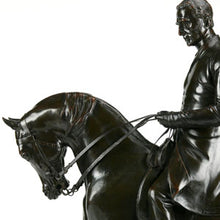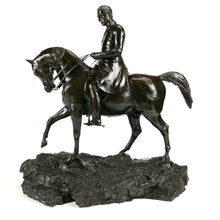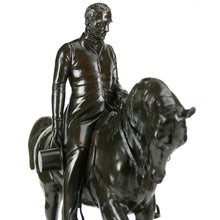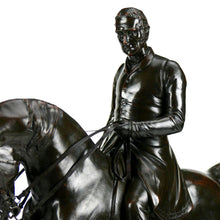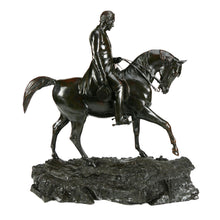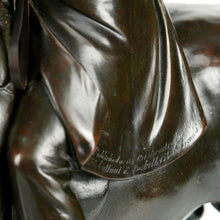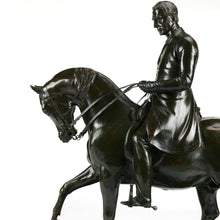The Duke of Wellington, 1844 - Edward Hodges Baily, RA
- Regular price
- £6,800
- Sale price
- £6,800
- Regular price
-
- Unit price
- /per
Adding product to your cart
Overall: 51cm (20in) x 48cm (19in) x 25cm (10in)
Literature: ‘Wellington Portrayed’, Charles Wellesley, Marquess of Douro, 2014
Electroform. Equestrian bronze of the Duke of Wellington (1769-1852) in long coat with top hat in his right hand, all upon a rocky ground. Engraved ‘Published as the Act directs. March 9 1844 / 1432 by Hunt & Roskell 156 New Bond Street’, and ‘No. 1432 Published as the Act directs / [Ro]skell / [B]ond steet / March 2 1844.’
The Iron Duke was famously irascible in his interactions with artists, as the painter Benjamin Robert Haydon recorded in his diary during a visit to Walmer Castle in 1844. Edward Baily was there carrying out a commission for the firm of Bond Street silversmiths soon to undergo a name change from Storr & Mortimer to Hunt & Roskell. Baily was tasked with producing the model from life for the present equestrian statuette. During the sittings the Duke became characteristically irritable, demanding of Baily ‘why artists could not be content with what they had done already. But then, ‘according to Haydon ‘got up on the horse, and Baily modelled away.’
Read more
Edward Hodges Baily (1788-1867) was born in Downend, Gloucestershire, the son of a woodcutter who specialised in carving ship's figureheads. He inherited his father’s interest in sculpting and produced models in clay and wax. At fourteen he was placed as an accounts clerk in a Bristol mercantile house but continued model making as a hobby. At sixteen he was recommended to the celebrated sculptor John Flaxman, into whose London studio he was accepted as an assistant. He won the silver medal of the Society of Arts for a plaster figure of Laocoön shortly before being admitted to the Royal Academy Schools at the age of twenty-one. In 1817 he was elected as an Associate of the Royal Academy (ahead of John Constable). Election as a full Member followed in 1821 and Baily’s Diploma Work given to the RA was a bust of his mentor Flaxman.
From 1816 to 1846, Baily was the Chief Modeller for Rundell, Bridge & Rundell, goldsmiths to the Royal family, where he was responsible for creating the Doncaster Cup trophy in 1843 and the Ascot Gold Cup in 1844. Baily’s also worked for celebrated silversmith Paul Storr who quit Rundell, Bridge & Rundell to enter into a partnership with John Mortimer in 1822. Baily’s large scale marble sculpture Eve at the Fountain was derived from a Storr & Mortimer design and was among the most popular individual sculptures in Britain at the time. It was widely reproduced in reduced sizes in both Parian and bronze.
Amongst Baily’s major public works were friezes for both Marble Arch and Buckingham Palace. His high profile statues included two busts of Wellington (one in the House of Lords) and Nelson atop his Column in Trafalgar Square. Baily was highly regarded by critics, patrons and students as an exponent of idealised sculpture, yet for all the popularity of his work his financial situation was precarious for many years and led to bankruptcy in 1831 and 1838. On the first occasion questions were asked in Parliament on his behalf because his financial distress had resulted from delays in receiving payment for sculptures at Buckingham Palace. Fortunately his appeals to the Royal Academy for financial assistance, were successful in the 1830s, as again in the 1860s, when they provided him with a pension of £200 a year as an honorary retired Academician.








